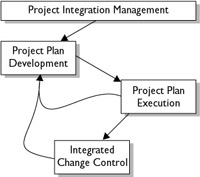Chapter 4: Implementing Project Integration Management
|
| < Day Day Up > |
|
Overview
What the heck is project integration management? Project integration management is the heart of project management and is made up of the day-to-day processes the project manager relies on to ensure that all of the parts of the project work together.
Put simply, project integration management is the way the gears of the project work together.
Within any project there are many moving parts: time management, cost management, schedule conflicts, human resource issues, iterative planning, and much, much more. Project integration management is the art and science of ensuring that your project moves forward, that your plan is fully developed and properly implemented. Project integration management requires your project, regardless of it size and impact, to mesh with the existing operations of your organization.
Project integration management requires finesse, as you, as the project manager, will have to negotiate with stakeholders for a resolution to competing project objectives. It requires organization, as you'll have to develop, coordinate, and record your project plan. It requires the ability to accomplish your project plan. It requires leadership, record-keeping, and political savvy, as you'll have to deal with potential changes throughout your project implementation. And, perhaps most importantly, it requires flexibility and adaptability throughout the project execution.
In this chapter we'll cover three big topics you'll have to master to pass your PMP exam, and you'll also need these skills to successfully implement projects out in the world. These topics are
-
Developing the project plan
-
Executing the project plan
-
Managing change control
As you've learned already, all projects need a project plan-it's up to the project manager and the project team to create one. Then the project manager must work with the project team to ensure the work is being completed as it was planned. The project manager must follow all the subsidiary project plans, such as the Risk Management Plan, the Schedule Management Plan, and the Communications Plan. Finally, the project manager must work throughout the project to control changes across all facets of the project. Figure 4-1 shows the complete picture of project integration management.

Figure 4-1: Project integration management uses Development, Execution, and Integrated Change Control.
|
| < Day Day Up > |
|
EAN: 2147483647
Pages: 209